
6 Beautiful Trees All Year Round
Attractive throughout all seasons
Contents
Although many trees are renowned for their stunning features, their beauty can sometimes be fleeting and fades with the seasons. These decorative plants, which have a limited lifespan, often signify dullness in the garden. However, some ornamental trees stand out for their beautiful appearance that lasts all year round. Almost everything about these trees is decorative: the flowers, the fruits, the autumn foliage, and even the bark. Whether flowering trees or conifers, discover our selection of six trees that remain beautiful throughout the year, allowing you to extend the aesthetic interest of your garden!
Heptacodium miconioides
Uncommon in our gardens, Heptacodium miconioides is nonetheless endowed with numerous qualities. This small tree, native to China and about 3 to 5 m tall, displays an elegant rounded and well-opened habit at maturity, giving it a lovely stature. The heptacodium flowers from August to September, sometimes into October. It then reveals clusters of star-shaped white and fragrant flowers. This fragrance evokes jasmine. But the highlight is yet to come. Over time, the flowers fall, revealing deep pink calyces that almost turn red! These colourful clusters remain in place until the first frosts. A beautiful asset to enhance the garden in the late season!
Its deciduous foliage also takes on a lovely red hue in autumn before falling. But that’s not all! The Chinese heptacodium is also interesting for its bark, which peels in strips during winter. The silhouette of the tree is then highlighted by the warm beige to brown colour of the trunk.
Be aware that this rare tree has been given several common names: Miconia-flowered heptacodium, seven-flower tree of Zhejiang, or the tree of the seven sons’ flowers of Zhejiang. The Heptacodium miconioides tolerates partial shade, but its flowering is more abundant in full sun. Vigorous and very hardy, it adapts to all types of soil, and its cultivation is very easy.

Heptacodium miconioides (photo on the left source PBK)
The false camellia or Stewartia pseudocamellia
The Stewartia pseudocamellia is a small tree of Asian origin that is rather unknown. Reaching about 5 m in height and 3 to 5 m in width in our gardens, it has a broad columnar habit, with a crown that rounds out with age. Although this small tree is deciduous and becomes naked in winter, it still has other assets that make it aesthetically pleasing throughout the year. Firstly, the Stewartia offers a stunning white flowering during summer (July to August, sometimes until September). Its flowers, with corollas and a golden centre, and slightly frayed petal edges, are similar to camellia flowers. This explains the French name given to it: the false camellia Stewartia. The inflorescences are followed by the production of fruits in the form of capsules. Next, its foliage turns beautiful shades with the arrival of autumn! Its green leaves then change to orange, red, and finally purple, before falling. Lastly, let’s not forget its very interesting smooth bark that adds colour during the winter months. This bark, reddish-brown in colour, peels in irregular plates and takes on beige tones over time.
With quite good cold resistance once established, the Stewartia pseudocamellia prefers semi-shaded exposures, sheltered from the wind, as well as acidic, humus-rich soils that remain slightly moist.
- Discover more stewartias in our range
- Find all the information on the stewartia in our sheet

Stewartia pseudocamellia
Discover other Trees and large shrubs
View all →Available in 0 sizes
Available in 1 sizes
Available in 1 sizes
Available in 1 sizes
Available in 1 sizes
Available in 1 sizes
Available in 1 sizes
Available in 1 sizes
Available in 2 sizes
Available in 1 sizes
The Strawberry Tree or Arbutus unedo
Very common around the Mediterranean, the strawberry tree is a small tree that can reach heights of 3 to 10 m. Its dark green foliage is evergreen and thus remains present all year round. By the end of summer, it adorns itself with numerous clusters of small flowers. These nectariferous white bells, reminiscent of lily of the valley flowers, are highly appreciated by pollinating insects. At the same time, the fruits make their appearance. These are called strawberries. It is for its red fruits that the strawberry tree has been named the “Tree of Strawberries”. An edible and sweet berry, the strawberry has a rough skin, gradually changing from green to red and takes a year to reach ripeness. The reddish-brown bark, which exfoliates slightly, is also decorative.
Patience is required with Arbutus unedo, as its growth is rather slow. However, it enjoys good longevity if the growing conditions are suitable. The strawberry tree thrives in sunny locations. It withstands heat and sea spray well. However, severe cold can damage it, which is why the tree of strawberries is preferably planted in regions where winters are milder (south of the Loire, southern Atlantic coast, or Mediterranean regions).
- Discover more strawberry trees in our range
- Find all the information about the strawberry tree in our sheet
- To learn all about the strawberry and its harvest, visit Olivier’s blog page: The Strawberry: an edible fruit to discover
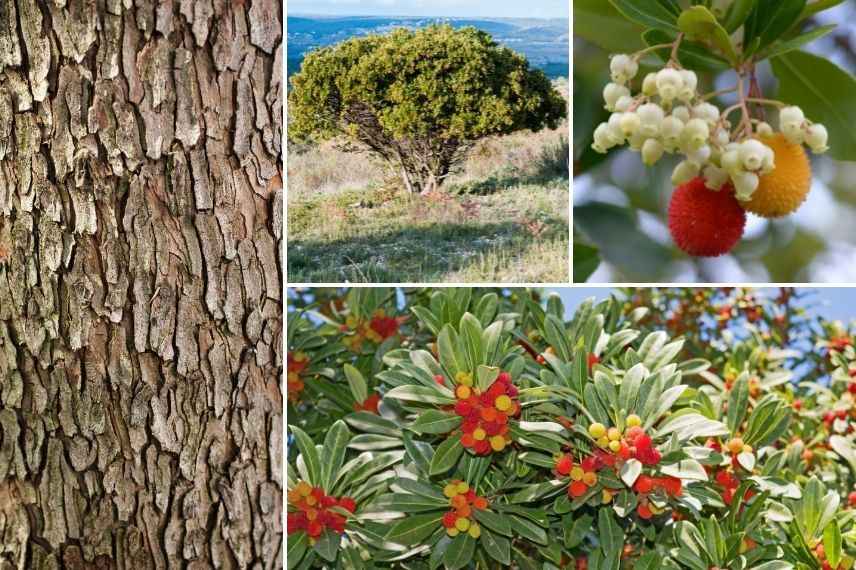
Arbutus unedo
The Monkey Puzzle or Araucaria araucana
Large tree that can reach heights of 15-20 m, the monkey puzzle or araucaria is valued for its geometric branches. This conifer spreads its dark green, glossy branches horizontally in a very graphic manner. The branches are adorned with small, hard, spiky leaves that are tightly imbricate, making it impossible to climb this tree. These clusters of scales have also earned it the nickname “monkey’s bane.” Evergreen, Araucaria araucana impresses us with its original appearance all year round!
Reserved for large gardens in mild, humid climates, the araucaria thrives in full sun, in non-calcareous, cool, and well-drained soil. Its watering should be regular until it is well established. It is also recommended to mist its foliage during the three summers following its planting. After that, maintenance will be very easy. However, note that the growth of this conifer is slow.
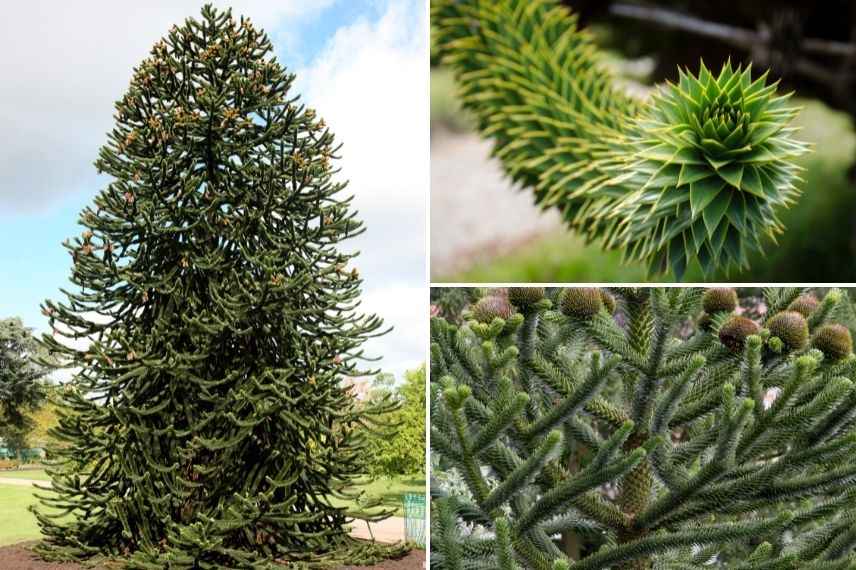
Araucaria araucana
Birches
Reputed for their barks, the birches are trees that maintain their beauty throughout the seasons, even in the depths of winter. Indeed, not only do many of these trees offer stunningly varied barks, but they also display a dazzling golden-yellow foliage in autumn! Among the most beautiful birches, we can mention the Himalayan birch (Betula utilis jacquemontii) and the Chinese birch Betula albosinensis ‘Fascination’. Quite different from each other, the former has a very white bark, while the latter is distinguished by its coppery to orange-brown bark. With an upright habit, these deciduous birches are beautiful decorative elements that can be integrated into a winter garden, positioned at the back of a low bed so that their trunks are clear and well visible. As spring returns, in March-April, the flowers blooming in the form of pendulous or upright aments also add a charming touch to these trees. However, it is worth noting that the pollen released by the inflorescences can be allergenic, and some individuals are particularly sensitive to it.
Thriving in full sun or partial shade, birches adapt to all types of soils, whether dry or moist. Thanks to their excellent hardiness, they withstand cold climates very well. However, they do not thrive in excessively hot climates.
- Discover our selection of birches with the most beautiful barks
- For more information, visit our comprehensive guide on Birches: planting, pruning, and maintenance

Barks of Betula albosinensis ‘Fascination’ and Betula utilis jacquemontii
Decorative Bark Maples
When we think of maples, we first consider their beautiful leaves. However, there are maples that stand out due to their remarkable barks. The Acer griseum, Acer davidii, and Acer capillipes are among these uncommon maples. The Acer griseum is commonly known as the paperbark maple or cinnamon maple for its brown-orange bark that continuously exfoliates. It forms rolls, resembling cinnamon sticks. The other two, the Acer davidii (David’s maple) and the Acer capillipes (red-streaked maple) are referred to as “snake-skin maples” due to their smooth, green, and striated bark, reminiscent of a reptile’s skin. All three are deciduous, and these maples are also appreciated for their vibrant autumn colours of lobed leaves. The very discreet spring flowering gives way to pendulous, winged fruits, known as samaras.
These exceptional maples are very hardy and do not exceed 10 m in height at maturity. To fully enjoy the beauty of these trees, plant them in isolation in partial shade (or in full sun for the Acer griseum).
- Discover our range of maples on our site
- Find all the information in our dedicated sheet: Maples: planting, pruning, and care
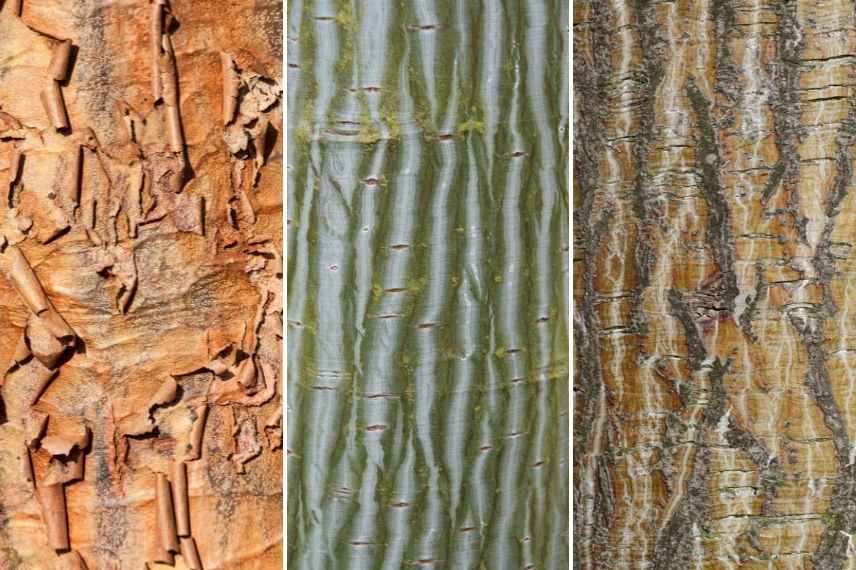
Barks of the Acer griseum (photo ninepennies), Acer davidii (photo Tony Hisgett), and Acer capillipes
- Subscribe!
- Contents

































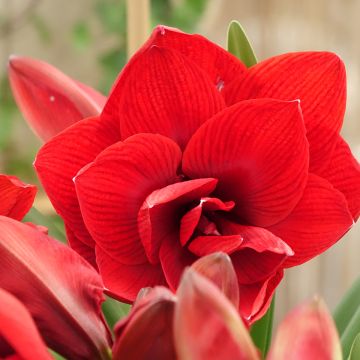




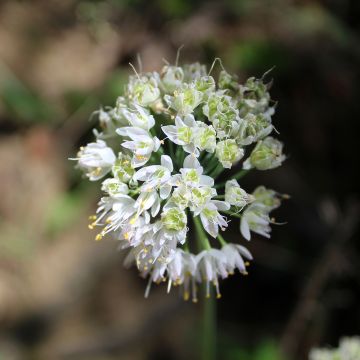
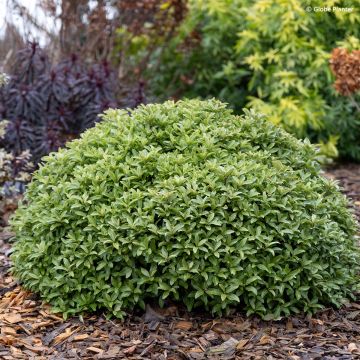
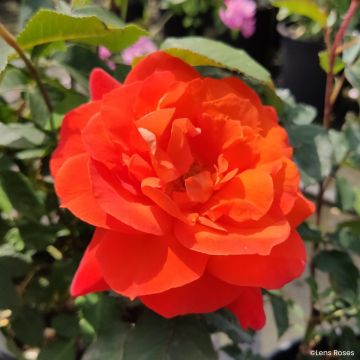

Comments